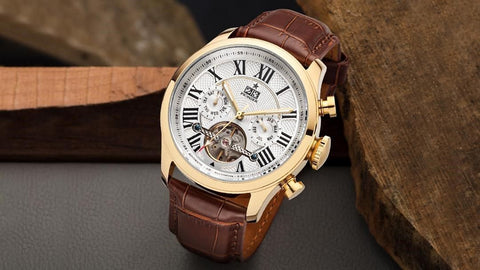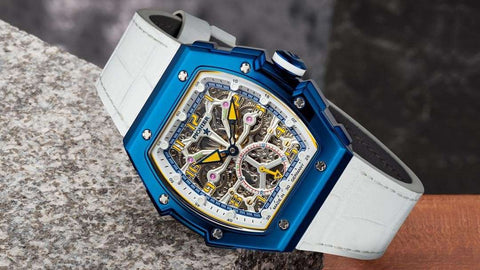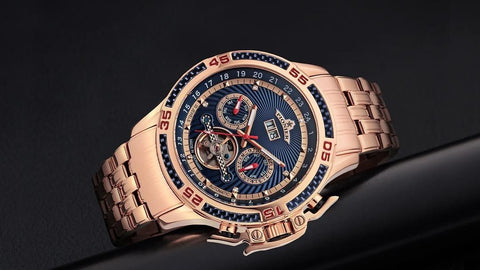You've undoubtedly heard of automatic watches if you've ever had an interest in horology. These amazing watches are among the most visually appealing and functional watches available. What you might be wondering, though, is how long an automatic watch lasts. If you're thinking about buying an automatic watch, know that they can last a lifetime with proper maintenance. However, you must learn how to care for these lovely mechanisms. In this blog post, we'll go into greater detail about the lifespan of automatic watches and provide you some important upkeep advice as well.
Back to the basics
First and foremost, you should remember that the more intricate a watch is, the more care and attention it needs to be maintained. It is crucial to exercise caution while setting the time. Never set the date if the watch is showing a time between 3 a.m. and 9 p.m. The "danger zone" is another term for this. The mechanisms that change the date are configured to operate during this time - we don't mean the actual time, but rather what the watch indicates.
You run the danger of destroying or ruining the tiny gears involved in this process if you attempt to set the date during this period. Find out about any extra maintenance requirements or things to watch out for if your watch has any additional complications. A handbook is typically included with timepieces, so you should be good.
Be mindful of where you store your watch
Automatic watches are very durable, however, as with any machinery you should make sure to store it in an appropriate environment. Be careful not to expose your automatic watch to extremely high or low temperatures. Overheating can be harmful as it might dry out the oil that keeps the gears functioning properly.
In the meanwhile, sudden temperature changes may cause the watch's gears and other parts to expand or contract. Ideal temperature is always room temperature. You should be fine as long as you don't expose your automatic watch to abrupt or drastic temperature changes. Additionally, stay away from excessive humidity, particularly if the water resistance level on your watch is inadequate.
Moreover, be cautious around magnetic fields, which are the worst enemy of an automatic watch. This is particularly valid for vintage timepieces. There is a chance that magnetic forces will completely upset the escapement. For this reason, we always advise not keeping your watch in close proximity to your WiFi router or on top of your phone for an extended amount of time.
Wind your automatic watch properly
Despite being referred to as self-winding watches, automatic watches do need to be wound once before being worn. Additionally, if you don't wear your automatic watch for a long period, you will need to rewind it, as automatic watches rely on the kinetic energy of your arm movements to function. Having said that, if you adhere to a few basic instructions, winding an automatic watch is quite simple.
- Before winding your watch, remove it from your wrist. This is valid even if you modify or tweak any of the settings. You run the danger of breaking the crown or overstressing the movement if you wind the watch by keeping it on your wrist at an odd position. It is always advised to remove your watch, hold it in your hands, and turn the crown slowly to wind it.
- Once you sense resistance, stop pushing the crown. The majority of automatic timepieces are equipped with a mechanism that prevents the movement from being overwound. But if you continue to press over that point of resistance, you run the risk of damaging the mechanism. When you think the crown shouldn't go much farther, always stop.
- You most likely won't need to wind your watch if you wear it daily. Remember, there's a reason why self-winding watches are called automatic watches. You won't need to wind your watch every day unless you've been keeping it in the closet for a longer amount of time.
How to clean an automatic watch
If you're concerned that your watch might become dirty, remember that a quick wipe every now and again is preferable to a deeper cleaning! To avoid dirt, dust, and grime accumulation, we always advise wiping your watch down with a soft cloth every day or at least once every couple of days. If you're still determined to clean your watch more thoroughly, use a soft cloth and a very mild cleanser. Mild soap should be okay. Keep your cloth from getting too moist! Simply dampen it a little and then gently clean your watch's lens, case, and band.
You should never attempt to clean your watch under running water, especially if it isn't water resistant! Avoid using chemical detergents and cleaners at all costs. Get in touch with the watchmaker to find out whether they provide any maintenance services if you believe your watch needs an extensive internal cleaning. Never try to open your watch on your own! Because the gears within are so little, they could easily break if not handled with the right tools. Only a specialist has the equipment and knowledge required to open and adjust an automatic watch safely.
Top Tufina Automatic Watches
Havana Pionier | P7001-2 | Gold
A lovely automatic watch with a gorgeous tapisserie dial. Equipped with a full calendar function, Havana is one of our most practical timepieces.
Milano Pionier | GM-519-1 | Blue
Protected by the Incabloc shock protection system, Milano is an extremely durable automatic watch. The angular design of the case complements the skeleton see-through dial, creating a modern look.
Amsterdam Calendar Pionier | GM-515-11 | Rose
Made with carbon fiber, high-grade stainless steel and photoluminescent hands, this superb automatic watch is robust and extremely fashionable. Featuring a full calendar function and 12 diamonds on the dial, Amsterdam scores high in terms of utility and style.
Final Notes
To sum up, how long an automatic watch can last mainly depends on its maintenance. With proper care, these delicate timekeepers can serve for a lifetime. Every single thing from understanding the dynamics of setting time and dates to the awareness of environmental factors like temperature, humidity and magnetic fields is essential in maintaining their functionality. Additionally, proper winding and cleanliness are also necessary for a good lasting performance. By following these guidelines, your automatic watch will remain a trusted accessory that you can treasure for years ahead.









Leave a comment